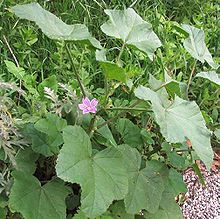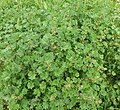
Althaea officinalis, the marsh mallow or marshmallow, is a species of flowering plant indigenous to Europe, Western Asia and North Africa, which is used in herbalism and as an ornamental plant. A confection made from the root since ancient Egyptian times evolved into today's marshmallow treat, but most modern marshmallow treats no longer contain any marsh-mallow root.

Malva moschata, the musk mallow or musk-mallow, is a species of flowering plant in the family Malvaceae, native to Europe and southwestern Asia, from Spain north to the British Isles and Poland, and east to southern Russia and Turkey. Growing to 60 cm (24 in) tall, it is a herbaceous perennial with hairy stems and foliage, and pink saucer-shaped flowers in summer.
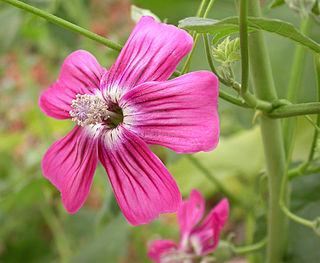
Malva assurgentiflora, formerly classified as Lavatera assurgentiflora, the island mallow, mission mallow, royal mallow, malva rosa island mallow, island tree mallow or malva rosa in Spanish, is a species of flowering plant in the mallow family.

Malva alcea is a plant in the mallow family native to southwestern, central and eastern Europe and southwestern Asia, from Spain north to southern Sweden and east to Russia and Turkey.

Malva sylvestris is a species of the mallow genus Malva in the family of Malvaceae and is considered to be the type species for the genus. Known as common mallow to English-speaking Europeans, it acquired the common names of cheeses, high mallow and tall mallow as it migrated from its native home in Western Europe, North Africa and Asia through the English-speaking world.

Malva neglecta is a species of plant of the family Malvaceae, native to most of the Old World except sub-Saharan Africa. It is an annual growing to 0.6 m (2 ft). It is known as common mallow in the United States and also as buttonweed, cheeseplant, cheeseweed, dwarf mallow, and roundleaf mallow. This plant is often consumed as a food, with its leaves, stalks and seed all being considered edible. This is especially true of the seeds, which contain 21% protein and 15.2% fat.
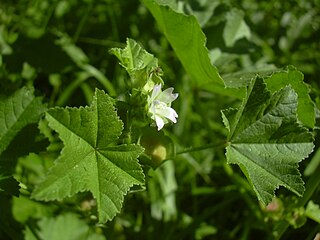
Malva parviflora is an annual or perennial herb that is native to Northern Africa, Europe and Asia and is widely naturalised elsewhere. Common names include cheeseweed, cheeseweed mallow, Egyptian mallow, least mallow, little mallow, mallow, marshmallow, small-flowered mallow, small-flowered marshmallowNafa Shak and smallflower mallow. It typically grows on agricultural lands and in disturbed sites such as roadsides.

Malva multiflora is a species of flowering plant in the mallow family known by the common names Cornish mallow and Cretan hollyhock. It is native to western Europe, North Africa, and the Mediterranean Basin, and it is naturalized in areas with a Mediterranean climate, such as parts of Australia, South Africa, and California. This is an annual or biennial herb growing a tough, somewhat hairy stem to a maximum height between 1 and 3 meters. The leaves are multilobed with flat or wavy edges, slightly hairy, and up to 10 centimeters long. The plant bears small pink or light purple flowers with petals just over a centimeter long. The fruit is disc-shaped with 7 to 10 segments.
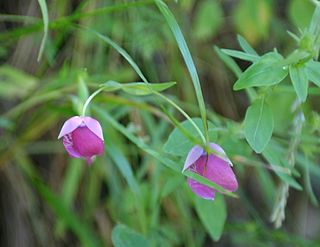
Calochortus amoenus is a species of flowering plant in the lily family which is commonly known as purple fairy-lantern.

Chaenactis santolinoides is a species of flowering plant in the daisy family known by the common name Santolina pincushion. It is found in California.

Sidalcea diploscypha is a species of flowering plant in the mallow family known by the common name fringed checkerbloom. It is endemic to California, where it grows in the woodlands and valleys of the central part of the state.

Sidalcea hirsuta is a species of flowering plant in the mallow family known by the common name hairy checkerbloom.

Sidalcea malviflora is a species of flowering plant in the mallow family, known by the common names dwarf checkerbloom, Greek mallow, prairie mallow and dwarf checkermallow.

Sidalcea oregana is a species of flowering plant in the mallow family known by the common name Oregon checkerbloom.

Malva punctata, commonly called spotted-stalked tree-mallow or annual tree mallow, is an annual herbaceous plant belonging to the genus Malva of the family Malvaceae.

Malva verticillata, also known as the Chinese mallow or cluster mallow, is a species of the mallow genus Malva in the family of Malvaceae found in East Asia from Pakistan to China. M. verticillata is an annual or biennial that grow up to 1.7 meters in high and can inhabit woodland areas of different soil types. The small, symmetrical flowers have five white, pink or red petals (0.8 cm) and thirteen or more stamens. Each flower has three narrow epicalyx bracts. The fruit is a dry, hairless nutlet. The leaves are simple and alternate.
Malva pusilla, also known as Malva rotundifolia, the low mallow, small mallow, or the round-leaved mallow, is an annual and biennial herb species of the Mallow genus Malva in the family of Malvaceae. Malva is a genus that consists of about 30 species of plants. This genus consists of plants named mallows. Mallows grow in many regions, including temperate, subtropical, and tropical areas.

Malva setigera, also known as Althaea hirsuta, the rough marsh-mallow or hairy marshmallow, is a species of annual herb in the family Malvaceae. It has a self-supporting growth form and simple, broad leaves. Individuals can grow to 28 cm (11 in).

Alcea digitata, the fingered hollyhock, is a tall hollyhock with large flowers native to the Middle East.
Malva unguiculata, the bryony-leaved tree-mallow, is a very tall perennial tree-mallow with large pink flowers native to the East Mediterranean.
